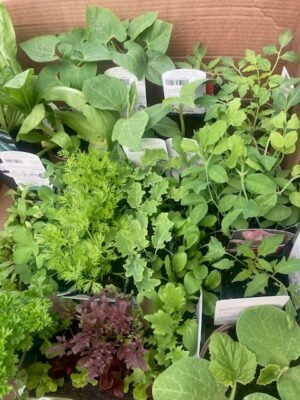Even in the shelter of the greenhouse it has been a cold, slow start to the spring this year – the endless rain in my part of the country has made getting outdoors a chore, at least up until very recently, and so I haven’t done as much sowing as I had planned to, and those seeds that have been sown have been very slow to emerge and to grow. I’m sure I’m not the only one who has turned to garden centre plants to fill the gaps in the veg beds.
Garden centres are filled with little starter veg plants at the moment, and I think they are brilliant. They take the guess work out of the hardest part of vegetable growing, which is getting the plants started in the first place. As most of the vegetables we grow are annuals, we have to bring on these tiny plants at the most unpredictable time in the year, with the greatest temperature swings and a high probability of sudden bad weather. And we have to make them sturdy and healthy enough to plant out into the ground and tolerate anything that comes their way, but often with minimal facilities – making the best of a bad job and ferrying plants between windowsills and the outdoors. When you buy little starter plants all of that work has been taken care of by professionals in the most perfect growing conditions, and so your plants are healthy and strong and ready to grow well.

Buying them this way also helps avoid the problem of over sowing. When faced with a packet of seeds and a whole summer ahead it is so tempting to sow half a packet or even the whole lot, without necessarily thinking about the reality of where the resulting plants are going to go. But starter plants are expensive. Not very expensive, but more than a packet of seeds, and so I am forced to really think about how many of each plant I want and where I am going to put them: two courgette plants really will be enough for my whole family’s courgette needs, likewise three cucumbers. We can only really fit in five tomatoes, and so on.
However there are some tricks to using these plants. They are grown in ideal conditions, but your garden’s conditions are likely not ideal, or at least the weather that they will be subject to after planting out wont be, so there is a good chance that they will get a bit of a shock on introduction to your soil. They will have been grown in pretty sheltered conditions, which is why they look so healthy and soft, but that softness is exactly what will make them irresistible to pests – particularly slugs and snails. You can lose a whole trolley full of garden centre plants overnight if you don’t take some precautions.
You could of course plant them out and then surround them with all sorts of slug and snail fortifications, but in my experience very few of them work fully. In my experience the best way to get around this problem is to first plant them up into small pots of their own, and then grow them on in your own garden in relatively sheltered spot – not inside the greenhouse now, they need to start to get used to the great outdoors. Give them at least a week like this, maybe two, outside day and night, and only then plant them out. You will have far fewer slug and snail losses this way. Then once you plant them into the ground they will be acclimatised to your conditions, and will romp away.










